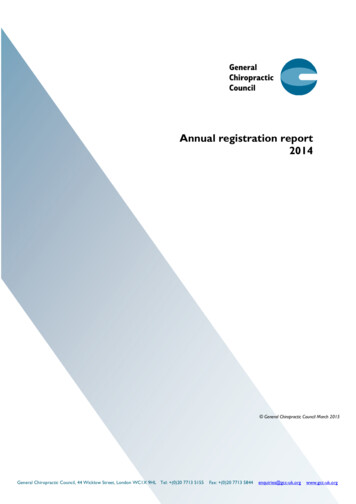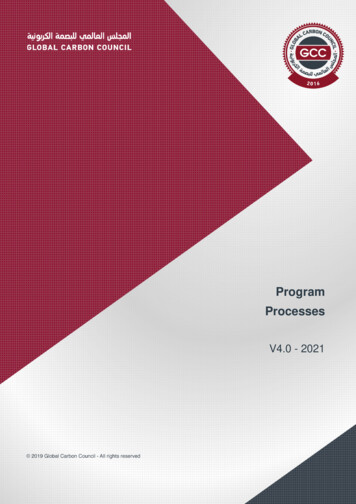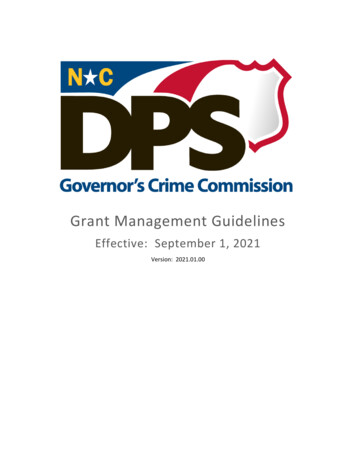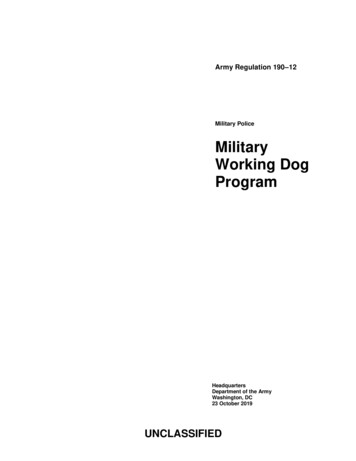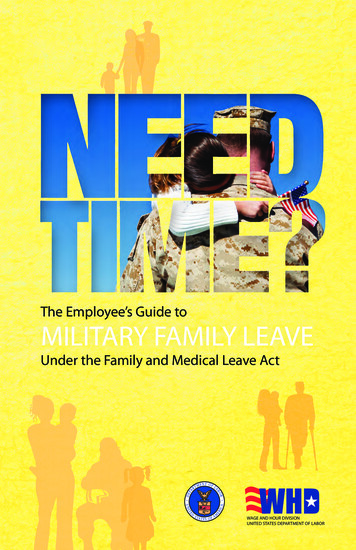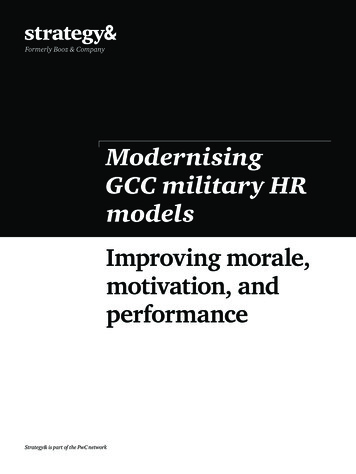
Transcription
ModernisingGCC military HRmodelsImproving morale,motivation, andperformanceStrategy& is part of the PwC network
ContactsAbout the authorsDubaiHaroon Sheikh is a partner withStrategy& Middle East, part of the PwCnetwork. He is based in Dubai and is theleader of the defence and operationspractices in the Middle East. He hasspecialised experience in buildingdefence support capabilities, focusingon logistics and supply chain strategiesfor militaries. He has linked these tonational defence industrial strategiesand to innovative ways for militaries tocreate partnerships with industry. Hehas led large military transformationscovering logistics, IT, HR, trainingcomponents, managing change, andcommunications at senior levels.Haroon SheikhPartner Bassem FayekManager onnect with the Ideation Centertwitter.com/ideationcenterBassem Fayek is a manager withStrategy& Middle East, based in Cairo.He is a senior member of the defenceand operations practices in the MiddleEast, with extensive experience workingwith militaries in the region. He hasled defence assignments across IT andlogistics, and recently has managedprojects on HR, career transition andmorale, welfare, and recreation formilitary ioncenter.comConnect with Strategy& Middle Easttwitter.com/ideationcenterJoseph Mourad and Abdul-AzizDriskell also contributed to this and.pwc.com/meConnect with y&
Executive summaryArmed forces in the Gulf Cooperation Council1 (GCC) need toconcentrate on human capital development after over a decade offocusing on modernising equipment and doctrine. To get the mostfrom this modernisation, GCC militaries need military humanresources (HR) models that recruit, retain, and train people to havethe appropriate skills during service, and then prepare them forretirement. Instead, GCC militaries are currently facing problems ofmorale, motivation, and performance. They lack people with thenecessary skills because it is difficult to “buy” military human capitalas they can military equipment.GCC governments need to reform military HR models so that theyattract the most talented individuals, provide them with propertraining, use them more efficiently, and support their post-retirementintegration into society. This will improve morale and provide the skillsrequired by heightened security situations and rising demand foradvanced capabilities.To achieve this, GCC militaries need military HR models that flexiblyassign careers to increase productivity and efficiency, offer attractivepay scales linked to skills and responsibility, promote mental andphysical health, use more flexible recruitment, and ensure properintegration of retirees into civilian life. These models should linkpromotions to performance, give service members more control overtheir careers, and encourage professional and educationaldevelopment. They should recruit the brightest and the best, provideinternationally comparable standards of training, implement retentionprogrammes, use civilians for non-operational functions, and drawupon civilian expertise in specialised areas such as high tech. Suchmilitary HR models will strengthen military human capital, providefulfilling careers for personnel, while improving overall forceeffectiveness, readiness, and performance levels.Strategy&3
A time to moderniseOver the past few decades, GCC militaries focused on inducting newequipment and modernising their operational capability. From apersonnel perspective, armed forces invested in training “front-lineoperators.” Unfortunately, broader HR reform was not on the agendaof military leaders. Instead, HR practices remain stuck in routinesinherited from the Second World War era, which has led to lowmorale, insufficient motivation, and inadequate performance.A new way of thinking about HR is critical because GCC militaries arenot attracting appropriately skilled people, nor are they providingthose they do recruit with the right training to complement modernequipment or meet military threats. Without these skilled personnel,GCC militaries are unable to get the most out of the last decade ofmodernising equipment and doctrine.4GCC militariesare notattractingappropriatelyskilled people.Strategy&
Military HR models understrainExisting GCC military HR models are under considerable pressure.Geopolitical and military trends are straining GCC military humancapital, and GCC armed forces are facing increasingly capableadversaries. The technological environment is also changing, withunmanned, autonomous platforms and weapons increasinglyappearing on the battlefield (see Exhibit 1).Exhibit 1GCC military human capital is under strainGeopolitical and military trends are making unsustainable demands on military HR modelsGeopolitical trendsThe rising military power of regionaladversaries requires GCC militaries toupgrade their human capital capabilitiesThe increasingly unpredictable nature ofterrorist activity requires a more adaptableGCC military workforce capable ofnon-traditional warfareMilitary trendsThe ever-developing threat of cyber attacksrequires GCC militaries to have technicallyproficient and knowledgeable personnelMilitaryhumancapitalFiscal pressure to make sound and justifiedfinancial decisions while spending moreefficientlyIncreasing deployment of partially or fullyautonomous platforms and weaponsReal-time data-driven decision making,cybersecurity, and collection of intelligencefrom signalsSource: Strategy&Strategy&5
Mission-critical capabilities cannot be outsourcedIn the 1980s and 1990s, GCC militaries would “acquire” capabilities fromfriendly and allied countries. They would use, for example, pilotsseconded to them from Egypt, Jordan, and Pakistan. However, this optionis no longer available. The modernisation of the GCC’s military platformsand systems has outpaced the capabilities of traditional allies. At best,GCC militaries can use expatriate contractors to plug gaps in supportfunctions in a partial manner, but this is at odds with their ambition ofdeveloping indigenous defence capabilities.Demographics are a disadvantageGCC nations have relatively small populations, resulting in a scarcity ofnational manpower that can serve in the armed forces. The small volumeof military human resources makes it difficult to invest in staff colleges,war colleges, and other specialist and local training institutions in theGCC. Consequently, militaries in the region traditionally either haverelied on domestic civilian education facilities or have sent theirpersonnel abroad for training and education.Legacy peacetime military HR models cannot handle operational pressuresGCC militaries developed their military HR models during an era ofrelative peace and stability. These models cannot cope with today’s tempoof military operations and rapid technological change.6Strategy&
The military HR model is notworkingThe weakness of the peacetime military HR model is evident in the lifecycle of military personnel. The current military HR model has anunattractive recruitment process compared to civilian opportunities, itdoes not give personnel the professional skills their armed forcescareers require, it does not use them to their full potential, and it doesnot prepare them for their departure to civilian life when they retire(see Exhibit 2).Recruitment is unappealing compared to the private sectorGCC militaries limit recruitment to entry-level personnel who are thentrained as cadets. This initial training provides standard military skills thatare unattractive when compared to the skills that companies impart tothose joining the private sector. Personnel obtain subsequentspecialisations during the course of a career through trainings — or not atall. By contrast, the U.S. military recruits entry-level personnel and looksfor potential officer recruits with college degrees in various disciplines,thereby resulting in an intake with a diverse set of skills from day one.Exhibit 2The military HR model does not provide personnel with the necessary skills nor fulfillingcareersThe GCC military personnel life cycleUnappealingrecruitmentLack of professionaltrainingPoor utilizationLack of preparation forretirementSource: Strategy&Strategy&7
Lack of professional trainingGCC militaries focus on training personnel for operations, with insufficientstress on managerial and professional skills. The lack of importanceaccorded to such aptitudes as project management, business management,organisation behaviour, IT proficiency, and languages deprives militaries ofthe ability to handle complex operational and procurement decisions. GCCmilitaries buy products and systems that they cannot fully exploit and thatrequire expensive contractors to maintain and operate. The failure toimpart commercial skills, and the concomitant inability to develop businesscases and undertake cost-benefit analyses, has a negative effect onoperations and procurement.GCC militaries also do not invest sufficiently in training people with thenew skills required by complex technologies. The professional training thatexists does not aid career progression, is often not high quality, and is nottransferable to civilian life. GCC military training rarely providesrecognized accreditation, nor do military trainers seek it from local,regional, or international institutions.Unsatisfying career pathsGCC militaries do not utilize their personnel efficiently, leading to capacitygaps and unsatisfying careers. They impose frequent, often unplannedchanges in assignments and locations on their personnel. A lack ofassigned career tracks and associated training limits personnelperformance. Members of the armed forces do not accumulate theexperience that leads to high performance. There is no incentive to seektraining and so work to one’s potential because pay and promotionschemes are often time-based.Sudden retirementGCC countries often impose abrupt and unplanned exit from service.Personnel have limited awareness of what retirement involves and havelittle time to make the transition from military to civilian life. GCC armedforces offer few programmes and benefits to service leavers and retirees toassist them with their personal and career transitions from the military tocivilian life. In some cases, militaries force personnel into retirement eventhough they can still make significant contributions. This needs to change,since during the course of their career, military personnel accumulateexperience and training, making them a significant resource.8Strategy&
A new military HR modelImplementing a new military HR model involves planning, execution,and assessment. Long-term planning and managing performance withdata are integral to the new military HR model and are involved inevery component of it.Each part of the defence sector — the armed forces, ministry ofdefence, privately and publicly owned defence industries — will needits own distinct HR strategy. Within each part of the defence sector,each organisation will have to develop its own career paths (seeExhibit 3, page 10). Although it makes sense for the three parts of thedefence sector to coordinate efforts with each other, such an attemptat alignment could prove cumbersome. Instead, the armed forces, theministry of defence, and defence industries could report to anoversight body, such as the ministry of defence’s inspector general,with regard to training and evaluation. The inspector general wouldthen share information and lessons learned.Strategy&9
Exhibit 3A new military HR modelArmed forces- Army- Air Force- NavyLong-term planningGrow and recruit thebest talent- Develop an attractiveemployer brand- Civilian roles- OutsourcingMinistry of defence- Headquarters- Other branchesDefence industries- Public companies- Private companies- HR strategy/objectives- Manpower planning- Career path designProvideworld-class training- Accreditation for militaryeducation- Career track educationand trainingOptimize human capitalutilization-Career tracksMerit-based promotionWell-beingSuccession planningSupport exit and integrationinto civilian society- Retirement policy- Career transition- Social benefitsManage performance with data- HR key performance indicatorsManage performance with dataHR keyperformanceindicators- BusinessintelligenceBusiness intelligenceSource: Strategy&Each part of the defence sector will need to implement a new, four-stepmilitary HR model that builds defence human capital.1. Recruit the best talent at all levelsRecruitment campaigns need to attract top talent while communicatinga message to the broader population that a military career is appealingand worthwhile. This requires the defence sector to consider howsociety, particularly schools and universities, perceives it. Based onthese perceptions, the defence sector should craft an appealing valueproposition to potential recruits based on messages includingpatriotism, career opportunities, professionalism, adventure,humanitarianism, national values, and camaraderie. GCC militariesalso need to use marketing techniques that will engage a younger andmore digitally aware demographic, as the U.S. has done (see “U.S. Armyrecruitment campaigns”).10Strategy&
U.S. Army recruitment campaignsThe U.S. Army has used a variety of tools,including experiential marketing, to attracttop talent. Recent campaigns include: “America’s Army” game: In 2002, theU.S. Army financed a video game withan initial budget of US 10 million anda yearly budget of 1.5 million targetedat young Americans. In 2005, 40percent of Special Forces recruitsreported that they had played thegame. The game has gone throughmultiple versions and has won awards.The army even uses the game intraining programmes.2 Army Strong campaign: Launched in2006 with a yearly budget of 200million for five years, the campaignhelped attract 80,000 recruits. Thecampaign portrayed joining the armyas a commitment to transformingmentally, physically, and emotionallystrong recruits into powerfulindividuals. Virtual Army Experience: In 2007,the U.S. Army designed a mobileexhibit event to take people through acontrolled mission simulation. TheVirtual Army Experience uses a versionof the game, “America’s Army.” Theexperience uses a 19,500 square footspace in which people get animmersive eight-minute experiencefrom briefing to after-actionreview.3 Officership campaign: In 2009, theU.S. Army realized it had enoughyoung recruits but needed officers. Thecampaign emphasized the variouscareers within the army with focus onleadership and career progression inthe Army Strong context.Another aspect of recruitment is to use qualified civilians to performnon-operational functions. Western militaries have two or three civiliansfor every uniformed service member working in their ministries ofdefence (see Exhibit 4, page 12). GCC militaries, however, tend to useofficers and enlisted men for civilian tasks, which is a misuse of resources.Strategy&11
Some militaries and ministries of defence recruit at all levels, inparticular for leadership positions. For example, the Australian ministryof defence recruited its current Chief Information Officer (CIO) from theprivate sector,4 and the U.S. Undersecretary of the Navy was appointedafter he spent several years in the private sector as a consultant.5Exhibit 4Militaries increasingly hire civilians to conduct non-operational rolesTotal personnel,civilian and militaryU.S.731KMilitary to civilian personnelratio in ministry of defenceBreakdown of civilian workforcein U.S. Department of LogisticsEducationNon-construction engineeringFacility engineering and managementITFinancial managementAcquisitionProgramme managementHR and manpowerScience and technologyMedicalOtherAdministrative supportSource: Fiscal Years 2013-2018, Strategic Workforce Plan Report,US Department of DefenseSource: US Department of Defense, “Number of Military and DoD Appropriated Fund (APF) Civilian Personnel PermanentlyAssigned By Duty Location and Service/Component,” (As of December 31, 2017); Parliament of Australia, Defence personnel,Table 1: ADF workforce data 2007–08 to 2017–18 (https://www.aph.gov.au/About Parliament/Parliamentary Departments/Parliamentary l# ftnref5); Total British Armed Forces, Overview (early2018) tml)12Strategy&
2. Provide world-class trainingThe military HR model needs to provide service members with themultitude of new skills and practices upon which military success nowdepends. By design, this military education and training needs to provideaccreditation, to promote career progression and to create a pool ofidentified, standardised skills.Among the most important skills is the ability to use information andcommunications technology (ICT) and to manipulate data to navigatecomplex decisions. Other critical skills include technical and businessliteracy. All of these need to be taught to the highest level and in amanner than builds the capabilities and careers of individuals. This willbe challenging, because GCC countries as a whole have skills shortages.In particular, GCC economies lack skilled digital professionals.6 GCCuniversities also do not produce enough graduates with specialiseddegrees, depriving the economy and the armed forces of important skills.Such training will apply to existing personnel as well as recruits. Indeed,one of the problems is that some of those currently doing training mayhave outdated or unneeded skills. For example, military financialmanagement is often obsolete. Some GCC militaries capture data only forrecord keeping and reporting; they set budgets and manage costs simplyby controlling consumption. New IT systems, however, allow forcontinuous data monitoring of platforms and logistics, capturing vastamounts of information that are useful if they are analysed properly bytrained personnel. This can lead to improved budgeting. These newsystems are demanding in IT personnel terms, as professionals need tomanage dispersed IT platforms, ensure interoperability, and becybersecurity adept and operations ready.Training will also extend to making business case decisions based onopportunity costs, through-life management cost of assets, and costaccounting. Such skills will lead to improved procurement and aretransferable to civilian life. Business skills are particularly important formanaging outsourced functions. Militaries need supplier managementcompetencies to get best value for money instead of opting for the lowestunit cost third-party providers.Strategy&13
In some areas, GCC militaries may find it hard to build capabilitiesbecause of the small potential pool of recruits and the weakness ofmilitary and civilian education. Specialities in which a shortfall is likelyinclude digital and data analytics expertise. GCC militaries can use amixture of four options to build capabilities in critical areas, in additionto using civilian specialists for non-operational demands:1. Build capabilities by partnering with other militaries and the privatesector. Oman, for example, has built a Military Technical College inpartnership with private-sector players. GCC states can also buildconnections between their fledgling military education bodies and thewell-developed military education ecosystem that exists in Europe andNorth America. The U.S. military, in particular, has a large educationsystem providing high-quality academic, professional, and vocationaltraining and accreditation. GCC militaries will need to considercarefully the design of such connections and supporting institutions inthe region so that it aligns with operational needs and the new humancapital model.2. Seek regional or international accreditation for military training courses.Other militaries ensure that their training courses receiveaccreditation from external bodies. In the U.K., for instance, servicepersonnel (current, reserve, or retired) can take courses accredited bythe Chartered Management Institute.7 Other accreditations for U.K.military education come from the Institute of Leadership andManagement,8 BTEC/Edexcel, and City and Guilds of LondonInstitute.9 In the U.S., the Judge Advocate General’s Legal Center andSchool provides further education to lawyers through an American BarAssociation–recognized LLM in military law. In Australia, theAustralian Command and Staff College awards a postgraduate degreeaccredited by the Australian National University.103. Pay for personnel to take external vocational training courses. TheU.K.’s Enhanced Learning Credits (ELC) Scheme, for example, fundsstudy to obtain nationally recognised qualifications relevant to aservice member’s duties.114. Use digital technology to deliver remote training. In the U.K., forexample, the University of Lincoln has work-based distance learningprogrammes to enable remote military education in businessmanagement, engineering management, logistics management, andHR management. These courses are eligible for ELC funding.1214Strategy&
Defence-sector organisations require a diverse set of skills — intoday’s era of specialisation, there is no room for generalists — andhence need different career paths and trainings. Given their size, GCCdefence organisations should not try to have all these skills in-house.They can obtain these skills by updating their policies to allowexternal resources or service providers to complement those of theiremployees or those in uniform.3. Design professional career pathsGiven their small size and currently high operational tempo, GCC armedforces need to use talent efficiently and effectively. The main componentsof the military HR value chain will help militaries get the most out ofhuman capital by providing a clear career path with an attractive valueproposition, an ability to advance based on talent and demonstratedperformance, training programmes tailored to the chosen career path,and well-defined exit opportunities.Defence organisations need, however, to take a different approach tocareers in ICT, which has distinct needs. These organisations need fasttrack careers for ICT professionals to attract the best talent. This wouldmean that ICT should have younger one-star generals (equivalent tobrigadier general rank) than would be the case in other specialisations,giving them responsibilities that are typically only possible for seniorranks. This would allow GCC defence organisations to compete withtechnology companies in which young specialists are allowed freedom,are involved in decision making, and can shape or influence policy andtechnology. The CIO, for example, may need to be a two-star general(equivalent to major general rank) to exercise influence.Strategy&15
4. Assist with exit and integration into civilian societyMilitaries should support service leavers so they can make a smoothtransition from military to civilian life. They need to ensure that retireesfind jobs and integrate back into society, allowing the economy tocapitalize on the skills they acquired during their service. This meansdesigning pensions, retirement benefits, and career transition support inan integrated fashion. An important part of transition support is to adviseservice leavers on how to find a job. Given the need to develop the GCCdefence industrial ecosystem, and the nature of service leavers’ skills,such support should also encourage retirees to enter the private defencesector. Retirement and transition benefits need to be integrated into awider set of assistance (see Exhibit 5).Exhibit 5Career transition benefits need to be part of a wider set ofassistanceMilitary lifeIn-serviceCareerSocial well-being- Salary- Training andeducation- Career paths- Housing- Medical- OtherTransitionCivilian lifePost retirement- Pensions- Career transitionbenefits- Housing- Medical- OtherSource: Strategy&16Strategy&
An example of these wider benefits comes from the U.K., where theRegulated Qualifications Framework means that there is equivalencebetween military training and civilian qualifications.13 This allowsmilitary retirees to more easily advertise their skills to civilian employers.The U.K. has also created a public–private partnership to manage careertransition benefits. The Ministry of Defence’s Directorate of Training,Education, Skills, Recruitment and Resettlement (TESRR) and RightManagement, a private-sector HR company, run the Career TransitionPartnership (CTP).14 The government renewed CTP’s contract in 2015 for10 years at a cost of 100 million ( 140 million). The Ministry of Defencetypically notifies service leavers of their retirement date nine months inadvance so that they can arrange an interview with a TESRR officer andstart looking for jobs. During that time, service leavers access a variety ofCTP services including a dedicated job-search portal, an onlinecurriculum vitae builder, workshops, training courses, career consultants,and employment fairs. Service leavers can use CTP services for up to twoyears after retirement.Strategy&17
ConclusionGCC armed forces are undergoing a profound transformation. They areadopting new technologies and platforms, while their frequentoperations are straining their human capital. To reverse the currentproblems of low morale, poor motivation, and skills shortages, theyneed a new HR model that will recruit the best, train them to thehighest standard, use them efficiently, and then help them reintegrateinto civilian life. Such a model will meet the military HR needs of thefuture and treat their military personnel as national assets.18Strategy&
EndnotesThe GCC countries are Bahrain, Kuwait, Oman, Qatar, Saudi Arabia, andUnited Arab Emirates.1Blake Stillwell, “6 Military Video Games Used to Train Troops on the Battlefield,”military.com, May 13, 2016 ttlefield).2SPEVCO, Inc., “America’s Army Virtual Army Experience by SPEVCO,”January 20, 2017 (https://www.youtube.com/watch?v 8FfFxb9qbIk).3Allie Coyne, “Defence’s new CIO revealed,” iTnews, December 1, io-revealed-478802).4Ben Werner, “Thomas Modly Sworn In as Under Secretary of the Navy,” U.S.Naval Institute News, December 4, 2017 firmed-secretary-navy).5Samer Bohsali, Sevag Papazian, Melissa Rizk, and Ali Matar, “Empoweringthe GCC digital workforce: Building adaptable skills in the digital era,”Strategy& 2017 orkforcefull-report).6Chartered Management Institute, “Get your skills recognised,” ions/armed-forces).7Institute of Leadership & Management, “Future proof your career - with ILMQualifications” th-thearmed-forces).8City & Guilds, “Supporting the Ministry of Defence” an Defence College, “About the Australian Command & Staff Course(Joint)” anced Learning Credits Scheme ity of Lincoln, “Military Programmes” mmes/).12Find a regulated qualification, Gov.UK .1314The Career Transition Partnership (https://www.ctp.org.uk).Strategy&19
Strategy& is a global teamof practical strategistscommitted to helping youseize essential advantage.We do that by workingalongside you to solve yourtoughest problems andhelping you capture yourgreatest opportunities.These are complex andhigh-stakes undertakings— often game-changingtransformations. We bring100 years of strategyconsulting experienceand the unrivaled industryand functional capabilitiesof the PwC network to thetask. Whether you’recharting your corporatestrategy, transforming afunction or business unit, orbuilding critical capabilities,we’ll help you create thevalue you’re looking forwith speed, confidence,and impact.We are part of the PwCnetwork of firms in 158countries with more than236,000 people committedto delivering quality inassurance, tax, and advisoryservices. Tell us whatmatters to you and find outmore by visiting us e 2018 PwC. All rights reserved. PwC refers to the PwC network and/or one or more of its member firms, each of which is a separate legal entity. Please see www.pwc.com/structure for furtherdetails. Mentions of Strategy& refer to the global team of practical strategists that is integrated within the PwC network of firms. For more about Strategy&, see www.strategyand.pwc.com.No reproduction is permitted in whole or part without written permission of PwC. Disclaimer: This content is for general purposes only, and should not be used as a substitute for consultation withprofessional advisors.
A new military HR model Implementing a new military HR model involves planning, execution, and assessment. Long-term planning and managing performance with data are integral to the new military HR model and are involved in every component of it. Each part of the defence sector — the armed forces, ministry of
